
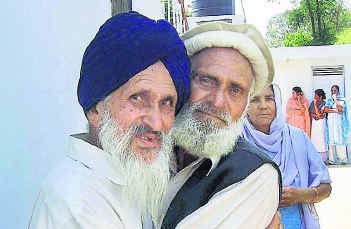 I had been sort of taking a wait-and-see approach to this news (pagh salute: preet) arriving out of England. It seems some punk kids started a blog to stir religio-ethnic hatred amongst Sikhs and Muslims. My hesitation was that I did not want to further enflame the story and further create the sort of reaction that the website had hoped.
I had been sort of taking a wait-and-see approach to this news (pagh salute: preet) arriving out of England. It seems some punk kids started a blog to stir religio-ethnic hatred amongst Sikhs and Muslims. My hesitation was that I did not want to further enflame the story and further create the sort of reaction that the website had hoped.
The blog of Jerome Taylor of the Independent had first written about the website and its intentions:
The website contains pictures of at least 25 Sikh women which the site’s administrators claim to have seduced alongside highly provocative remarks about the women and the Sikh religion.
Timed to coincide with the start of the university year – described in the site as a time when “[Muslim] soldiers go hunting for Sikh slappers” – the website’s creators encourage friends and readers to send in pictures of Sikh women they have seduced during freshers week.
The most vile part of the website was that it posted pictures of young women (that it claimed came from Sikh backgrounds) and wrote in the most nauseating way that males often talk. I did see the website and it was disturbing.
The current economic meltdown has made me reflect more and more on the role of community organizations/institutions during times of hardship and uncertainty. Our current economy is in bad shape, and we’re likely to feel the fallout in lost jobs, lost job openings, and lost homes/assets for months, possibly years, to come.
during times of hardship and uncertainty. Our current economy is in bad shape, and we’re likely to feel the fallout in lost jobs, lost job openings, and lost homes/assets for months, possibly years, to come.
What are our responsibilities to one another in times of crisis? The response is reliable and familiar for disasters, but with something as pervasive and private as personal finances and wealth, it becomes trickier. I have watched families fall through class brackets and learn to reevaluate their class identities and sense of pride in the context of previous recessions, but this recession seems like a harbinger of a deeper struggle to come.
Sikhi has a relatively clear requirement for service to others and wealth redistribution (daswand) from the more to less fortunate. What do we do when we find ourselves moving across classes or relative wealth? I would argue that now, more than ever, as people of faith our philanthropy, service, and efforts are needed in the same ways they would be for a disaster or catastrophe. We have an opportunity and moment to move beyond our personal egos and create support systems not only for the Sikh community, but for our larger communities. How many of our gurdwaras are located in areas that are impacted by the current mortgage foreclosure crisis and recession? Enough that I think we can make a difference.
I hope that in this stressful time we can rise to the occasion and get to know our neighbors by sharing and providing shelter, comfort, food, and resources. These dire times truly call for chardi kala and sarbat da bhalla, but we will be challenged to figure out what that means and how to make that happen in a time when all of us face uncertainty as individuals and community members.
In keeping with the recent Election 2008 theme on TLH, I ask you the following — which party do you think completes this sentence:
[x] believe that individuals should contribute time and resources to serving the poor, vulnerable, and less fortunate members of our society.
Do you think x refers to:
- Democrats; and/or
- Republicans.
So this past Saturday, Tina Fey, did a great job impersonating Sarah Palin’s “performance” at the Vice Presidential Debate on SNL. The body language, voice, and choice of words were right on and HILARIOUS!
Yesterday, Robin Abcarian, of the Los Angeles Times, wrote about the debate of body languages between Obama and McCain during this week’s Presidential Debate.
Abcarian wrote:
Obama sat like a jazz musician on his chair, one heel hooked at an angle, while McCain sat as if he might leap up at any moment, or stood impatiently waiting for his turn to speak.
Glass, a body language expert said that McCain was, “… like the Energizer Bunny [who] had some batteries put in. “We have never seen McCain so warm and fuzzy and likable and dynamic.”
This same expert thought that, “… Obama seemed unnatural at times. “Somebody coached him and did not do him a favor,” she said. “When he talks about an issue he’s passionate about, his gestures are fluid and real, but other times, he took his index finger and clasped it to his thumb, and it’s phony, it’s not real.”
However, at the end of the debate, body language experts declared Obama as the winner because “… a debate is won in the first 15 minutes and lost in the last two … Obama closed on a higher note than McCain.”
For our readers, who watched the Presidential Debate, what body language or mannerisms did you notice that would be great for another Saturday Night spoof?
From the Volokh Conspiracy:
Dear Senator McCain:
Repeatedly calling me and everyone else in the United States “my friends” is extremely annoying. In part, it’s just an irritating phrase. Beyond that, I’m not your friend. I don’t know you, and, from what I know of you, I don’t even really like you. Sorry to focus on such superficialities when the world economy is going to Hell, but you probably lost more votes with your constant repitition of “my friends” than from anything Obama said.
Sincerely,
David B. [link]
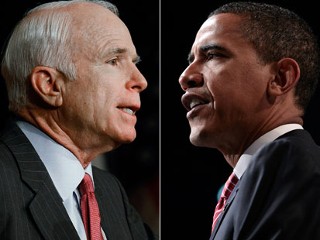 Reema (I’m signing on.)
Reema (I’m signing on.)
Both candidates used the phrase. And of course, because of my bias, it grated on my nerves when McCain used it. It was just amusing when Obama did. Anyone who is about to control my life and the lives of all US residents is not a friend, and they shouldn’t try to be. They just better know what they’re doing because everything (economy, environment- one in 4 mammals is threatened with extinction, social security, Medicare + Medicaid) seems to be falling apart at the same time. Not to be dramatic or anything. The only suggested economic solution from a Sikh point of view I found was vague, overly ambitious, and not really very palatable either.
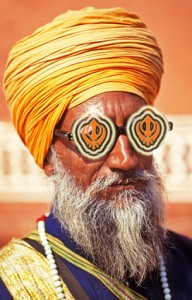 Has anyone else noticed how ridiculous the (US Presidential Election) campaigns have gotten? The ridiculousness has reached a new all time low in the past few weeks with both sides slinging mud, making tenuous connections, and outright lying. Admittedly, I have a preference for one side over the other, but like most people nowadays that means less than it used to and I have truly tried to be “fair” in my analysis of recent politicking. What I have seen from both sides makes me gag.
Has anyone else noticed how ridiculous the (US Presidential Election) campaigns have gotten? The ridiculousness has reached a new all time low in the past few weeks with both sides slinging mud, making tenuous connections, and outright lying. Admittedly, I have a preference for one side over the other, but like most people nowadays that means less than it used to and I have truly tried to be “fair” in my analysis of recent politicking. What I have seen from both sides makes me gag.
It seems to me that the strategies on both sides of the isle amount to this: avoid answering any questions; lie/stretch the truth whenever you feel you can get away with it (or even when you know you can’t), and don’t forget to act arrogant. If you doubt my generalization, I implore you to go to johnmccain.com or barackobama.com and look at the ads for yourself, watch the debates, or just snippets on youtube. What’s even worse is that the media has come to expect this childishness. Some of you may be thinking “So what?! – this is politics.” It is my hope that most of you don’t feel that way and just accept this behavior as the status quo.
I think what gets to me about this whole election cycle is how fundamentally un-Sikh-like the behavior has been. Let me explain. As a Sikh – I like to look at things through my Sikh glasses and when something is fuzzy or just doesn’t make sense, it is time to analyze why. Growing up as a Sikh and trying to live a gursikh life now, I have come to think of certain things – stand up for what you believe in, speak the truth – as almost requirements for being a good person. Gurbani provides numerous references to such virtues and while I am sure they are no different from many other religions, I think they are much more pronounced in the Sikh faith. Integrity, honesty, and courage are central to Sikhi. So from this perspective I evaluate recent campaign tactics.
Ultimately, my point is that the campaigns aren’t making their cases very well to someone like me, who is wearing gold rimmed, khanda shaped, Sikh glasses. Ideally, I’d like a President who I can feel good about, someone I see as a role model, and right now the choices leave much to be desired…
—
By the way, despite the above I feel one of the candidates is at least trying to steer clear of the muck and focus on the issues…so I give props to OBAMA for that. Go OBAMA!
Last week Bill Maher was a guest on the Daily Show, promoting his new movie Religulous and offering a clip. The clip happened to show a sardar in a London park, which was the extent of any Sikh’s appearance in the movie.
The name, ‘Religulous,’ is a portmanteau blending the words 1) religion and 2) ridiculous, and examines the overlap of those concepts. The movie’s proclaimed purpose is to promote doubt in the minds of those who have blocked doubt in religious teachings completely and subsequently hold totally irrational beliefs (i.e. reject evolution), though those who actually go to watch the movie probably wouldn’t be completely opposed to such doubt to be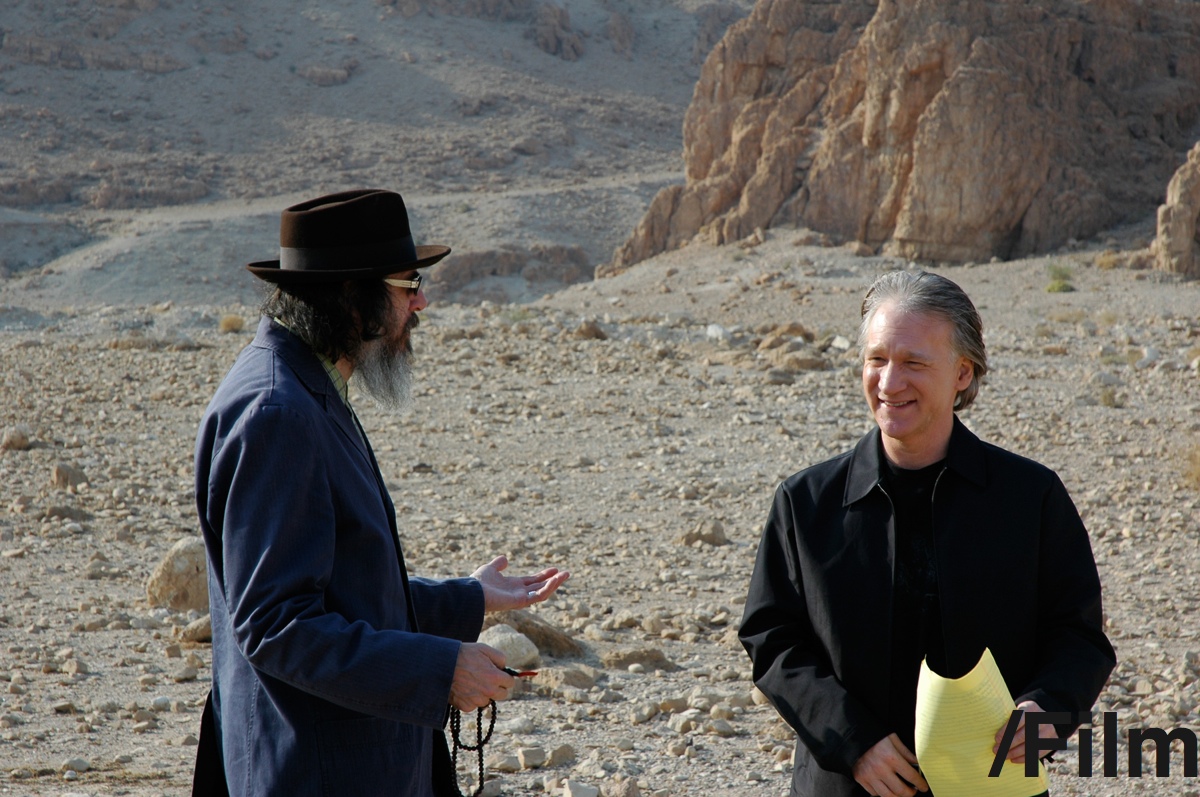 gin with. Of course at some point the explanations of rationality end, and there is the unknown. The point of the movie is to admit that it actually is unknown, and show that those who claim to know, really don’t.
gin with. Of course at some point the explanations of rationality end, and there is the unknown. The point of the movie is to admit that it actually is unknown, and show that those who claim to know, really don’t.
In the movie, Bill Maher interviews people from a variety of backgrounds and religious faiths (from a former head of the Human Genome Project and the former Director of the Vatican observatory to a British rapper). Some hold more nuanced views than others. He listens and asks questions of people who staunchly believe in literal translations of age old texts even when their beliefs scientifically absurd, and has some interesting (and comical) conversations. My favorite interview by far was with a very rational Vatican priest who happily admitted that Jesus’ birthday is not on December 25th and the Catholic church has absolutely no idea when it really is.
Often on this blog we have discussed what role our institutions should play in our lives and recently I had an opportunity to examine the issue anew. In a recent gurdwara council meeting I attended, one gurdwara decided to give a large sum of money to a group putting on a bhangra program. The group was not affiliated with the gurdwara. I will admit, I did not say anything at the time because I do not attend the gurdwara that decided to do this, but the incident did get me thinking about gurdwara funds and the concept of daswand.
When a gurdwara collects funds from the sangat – it does so under the pretence that the money is being collected to be put to some higher use, a use that we ourselves could perhaps not put it to, whether it be spiritual or practical. Usually we give the money as part of our daswand or some random seva to the gurdwara, but I think in every case it is understood that we are giving the money up to be put to a use that our Guru’s would have used it for – something necessary, something practical, and fundamentally “good.”
And as I write this post, some questions that I haven’t even answered for myself come to mind – Is the daswand I give to the gurdwara something I have a right to control – can I decide where it goes? If Sikhi is to be treated like a democracy, I would argue that absolutely I have every right to “vote” on where the funds go or at least have a chance to say something. But even in such a vote – should there be limits? Shouldn’t the funds of a gurdwara be spent on activities, which embody Sikh ideals and values? Presently, I am inclined to believe that sangat should have a say in where gurdwara funds are spent, but also that the options for spending funds should be limited to projects that actually embody and promote Sikh ideals.
But back to where we started – I brought bhangra up because it is something that can be debated – I’m not contending that it is an anti-Sikh activity, but at the same time, I don’t really think bhangra is something that perpetuates the Sikh way of life either. So I guess the dilemma in my mind in determining where the gurdwara should be spending its funds and where to draw the line…
Yesterday a friend sent me a link to a fascinating episode of a Discovery Channel program. The “Weapon Masters” series looks at various pre-industrial weaponry and their historical development, usage, and production. For the “entertainment” value, it pits traditional usage against a ‘pimped’ up version using modern machine-technology.
The show’s summary states:
Weapon Masters explores the history and science of ten weapons of the ancient world. Hosting the series is internationally known weapons expert and historian, Mike Loades. In each hour-long episode, Mike travels to a different international location to examine one particular ancient weapon and learn first-hand about the cultures where the weapon was used. He is assisted by an expert who demonstrates the techniques behind each weapon. He then challenges his co-host and master craftsman, Chad, to improve upon it using modern manufacturing techniques and materials. [link]
In a recent episode, aired in England, the subject was the quoit or Sikh Chakkar / Chakkram.
http://video.google.com/videoplay?docid=5547025680137386480In anticipation of Biden’s showdown with Palin tonight, as I wondered how Biden would perform in the strange, negotiated format that really favors Palin- allowing only 90 seconds for a response before two minutes for discussion (since every newscaster is cautioning Biden to not come across as chauvinistic) this picture gave me extra pause.
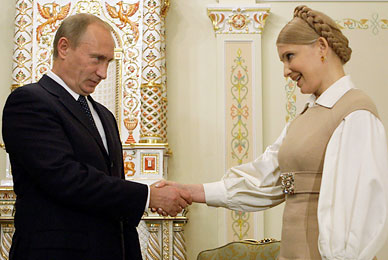
The headline reads: “Putin accuses Ukraine of having assisted Georgia during war”
That’s ….Putin ….accusing Ukraine (Tymoshenko is the Prime Minister) of assisting Georgia against Russia??
Ladies, they’re on our turf now!
In an effort to better understand the food habitats of Panjabi immigrants, Canadian researchers conducted a three-year study on the ingredients used in daily Panjabi meals and food choices made by Panjabi families.
Gwen Chapman, study leader and British Columbia University nutrition professor, stated:
“Since cardiovascular diseases and type II diabetes are more prevalent among Indians and they are linked to food habits, we wanted to understand what ingredients went into daily Punjabi or Indian meals.”
An important part of study was also understanding how cultural affiliations play a role in Panjabi immigrant food choices.
Researchers found that “in Punjabi families in British Columbia … separate meals are often prepared to accommodate elders who need traditional roti, daal and subji, and younger family members who prefer to balance Indian and “Canadian” foods.”
While reading this article I thought about how these food choices actually play out in immigrant Panjabi homes across North America. I remember the rotis without butter for those who have high cholesterol and the weekend meal of burger and fries for us “American” kids. There were also the interesting “masalaa” pastas, lasagnas, and pizzas that had a “Panjabi” twist (i.e. tons of garam-masalaa). I recall uncles’ refusing to eat “kaa-foos” prepared by their wives, aunties making tofu-sabiji, and mothers’ substituting olive oil for vegetable oil when making tarkas. Many of these food choices were an effort to provide more healthy meals as a “preventive” form of action against heart disease and diabetes; while others were made to satisfy taste-buds.
So I was wondering what interesting food choices have you seen Panjabi families make in the Diaspora both to satisfy taste-buds and become more healthy?
As part of its series on the upcoming federal elections in Canada, the Globe and Mail offers this article on the emergence and success of Sikhs in the Canadian political scene. Consider: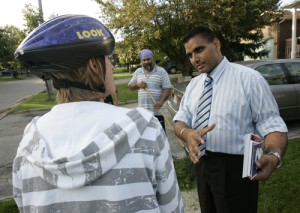
- Sikhs [are] the only group with a greater number of MPs than their share of the population.
- [In the House of Commons,] Punjabi is now the fourth most common language, after English, French and Italian.
- Many Sikh candidates live in Mississauga and Brampton, where they comprise 15 per cent and 19 per cent of the population respectively.
- [There are] 17 Punjabi newspapers in Brampton [Link]
These statistics are very impressive. I applaud the Sikh candidates for their participation in Canadian politics (which cuts against the suggestion that Sikhs are not sufficiently integrating into Canadian society). And I thank this publication for highlighting the political advancements that Sikhs are making in Canada.
That said, I am troubled by two parts of the article:
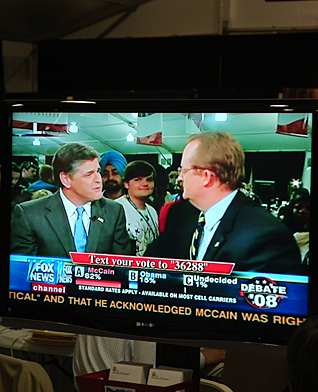 Were you watching the Presidential debate last Friday? Did you catch flashes of a sardar in a blue turban? I assume that anyone who did was equally as surprised as I was (though happily so). Well, who is the mystery man? He’s Arvinder Singh Kang, a twenty five year old who was the only Punjabi, and the only Sikh at the University of Mississipi when he came from Punjab to do a graduate degree.
Were you watching the Presidential debate last Friday? Did you catch flashes of a sardar in a blue turban? I assume that anyone who did was equally as surprised as I was (though happily so). Well, who is the mystery man? He’s Arvinder Singh Kang, a twenty five year old who was the only Punjabi, and the only Sikh at the University of Mississipi when he came from Punjab to do a graduate degree.
I came to the U.S. in the fall of 2005, as a graduate student at the University of Mississippi. From a proud Sikh family, I was the first kid from my village and from my maternal and paternal lineage to come to America for studies.
I brought twenty-something Puggs (turbans). I knew Japji Sahib by heart and had been exposed to Sikh history more than I had been to comics. All through my undergrad years, I had taught my juniors how to wear a turban. There was no doubt, whatever the circumstances might be, I would always be a Turbanator!
While boarding a plane from London’s Gatwick Airport, I sat beside a Sikh girl living in Houston who was born and raised in London. “…So it’s going to be hard to keep a turban in university”, she said in a lovely British accent.
“Much nee te kuch nee!” (What’s a man without a mustache) I had quipped. [link]
You can read more from Arvinder at Sikhchic.
The NYT recently covered the rising admission of Muslim students in Catholic schools, unsurprisingly, because there is a greater freedom to practice their faith in Catholic school than in “secular” public schools:
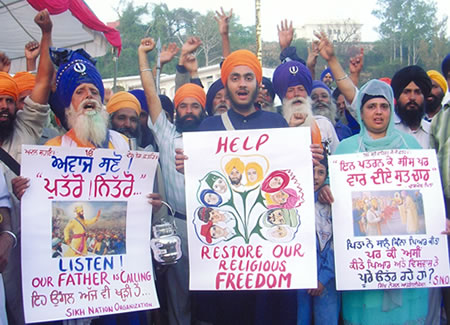
“There is respect for our religion here,” said Nadia Oualane, 14, a student of Algerian descent who wears her hair hidden under a black head scarf. “In the public school,” she added, gesturing at nearby buildings, “I would not be allowed to wear a veil.”
The experience of French Muslims mimics the crushing oppression that Sikhs and other religious minorities face under France’s harsh and discriminatory anti-religious policies:
The quiet migration of Muslims to private Catholic schools highlights how hard it has become for state schools, long France’s tool for integration, to keep their promise of equal opportunity…
Imam Bencheikh’s oldest daughter attends Catholic school. “It’s ironic,” he said, “but today the Catholic Church is more tolerant of — and knowledgeable about — Islam than the French state.”
In a recent state meeting between the French and Indian PMs, Sarkozy and Singh, respectively, reporters used the opportunity to reopen the question of how the religious ban has impacted Sikhs. Sarkozy ignored the disparate impact of the ban by claiming that its uniform application meant it had no discriminatory intent [Hat tip, Tejinder]:
Visibly irritated, Sarkozy continued, “But sir, we have rules, rules concerning the neutrality of civil servants, rules concerning secularism, and these rules don’t apply only to Sikhs, they apply to Muslims or others. They apply to all on the territory of the French Republic.”
His comments, however, about the universal nature of this ban are contradicted by his Minister of National Education, who indicates that there is an explicitly anti-hijab and anti-Muslim intent behind this policy:
“The head scarf is a sexist sign, and discrimination between the sexes has no place in the republican school,” France’s minister of national education, Xavier Darcos, said in a telephone interview. “That is the fundamental reason why we are against it.”
Muslim enrollment in Catholic schools is facilitated, in part, by marginally “freer” religious practice options, but also by the idea of a shared Abrahamanic history and God. Where do Sikhs find refuge, both in the context of education and religious practice, given their distinct history, practice, and interaction with Judeo-Christian institutions? France’s ban has been decried by human rights organizations and religious organizations, but little positive action has taken place against the ban. Indeed, in some cases the State’s reaction seems retaliatory.
Though this may not be the best analogy, I’m going to make it. It seems the Congress party in Haryana made the demand for a separate Gurdwara committee, in order to mobilize Sikh votes in their favor (at least according to one news source).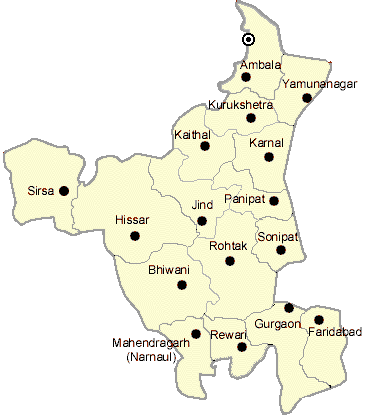
What is also well known is that Haryana’s Sikh vote has traditionally been mobilised by the SAD(B) for Devi Lal and then his son Om Prakash Chautala’s party. After 1984, the anti-Congress vote headed in that direction even more. By all accounts, the 2005 Assembly elections — also the one in which the Congress manifesto included the demand for a separate gurdwara management body for Haryana — constituted a break in the story. According to a CSDS survey, 50 per cent of the Sikh vote in Haryana went to the Congress in 2004, and only 35 per cent to Chautala’s INLD. [link]
And Sarah Palin- as qualified as she may be- was not selected to run as Vice President because of her outstanding qualifications, but for her token status as a woman. It was hoped that she would fulfill the dreams of Hillary supporters who wanted the glass ceiling in the White House shattered. (From what I’ve seen in the polls though, this doesn’t seem to have worked. The women who rallied behind Hillary don’t want a token representative.)
 This post is sort of dedicated to P.Singh. Let me first begin by saying that I agreed with ALL (and I use that word only after re-reading all of his comments) of the points that he made in a prior post (not all of his comments in other posts, but I digress….).
This post is sort of dedicated to P.Singh. Let me first begin by saying that I agreed with ALL (and I use that word only after re-reading all of his comments) of the points that he made in a prior post (not all of his comments in other posts, but I digress….).
However, I did want to revisit the topic of Dr. Pashaura Singh in light of some more news, posit a contrarian viewpoint based on an academic article, and then revisit the question of endowed Sikh chairs.
Update on Dr. Pashaura Singh
On Friday of last week, Sikhs throughout California organized buses down to the UC Riverside campus to protest Dr. Pashaura Singh’s hire as the chair of the endowed Jasbir Singh Saini Chair in Sikh and Punjabi Language Studies. While newspaper articles stated that over 300 people were in attendance, my own eye-witness sources claim that it was in excess of 500.
Earlier today I stumbled on this article in the Montreal Gazette detailing the suspension, and now calls for a speedy trial, for a Sikh boy accused of assault:
The teenager made his first appearance on the charges in Montreal Youth Court yesterday where he pleaded not guilty to three counts alleging he used a kirpan, a Sikh religious object that resembles a dagger, to threaten his schoolmates.
This case comes on the heels of another landmark Quebec case in which Canada’s Supreme Court unanimously voted to protect the right of Sikh school children to wear the kirpan (with some limitations on its use) in 2006.
But did the boy actually draw, or use, his kirpan during the argument? At first blush, it sounds like this was a schoolyard disagreement, but if the boy drew his kirpan it would be incredibly inappropriate, both under dharmic understandings and under school policy. But on reinspection, it’s unclear if this incident actually ever happened, or if this is a racist reaction against the kirpan. The boy’s lawyer, the same man who argued the Supreme Court case for accommodation of the kirpan, believes the reaction is racist:
Grey accused the Montreal police and the Marguerite Bourgeoys school board of “overreacting.” He also said a large part of Quebec society has never accepted the Supreme Court’s decision.
“I think that what we’re witnessing – it’s my opinion and the court will decide – is a deep bias against the kirpan that has never died in Quebec…”
If his lawyer is correct, then this brings up a larger issue: how do inclusion policies and values translate on the ground if a region or group is hostile to accommodation?
Legal protection of the kirpan is vitally important and relevant and worth protecting, but, if this incident did not take place, how many Sikh children will be pressured, harassed, and suspended from schools for exercising their right to practce their faith? In this case, the school board is not an advocate for the Sikh child (and in the previous kirpan case, when the school drafted an accommodation policy it was invalidated by the school board as well); if that democratic channel fails, then how can we support families in this position?
[Joint post by Singh and Reema]
The plot is thick. Nearly 100 million Phillipine pesos are at stake (roughly $ 2.2 million USD). Multiple groups of god-father like figures control entourages of loyal henchmen. Money is being used for unauthorized purposes, and powerful figures have put competitors out of play – risking not just the money, but [dun dun dun]…their lives!
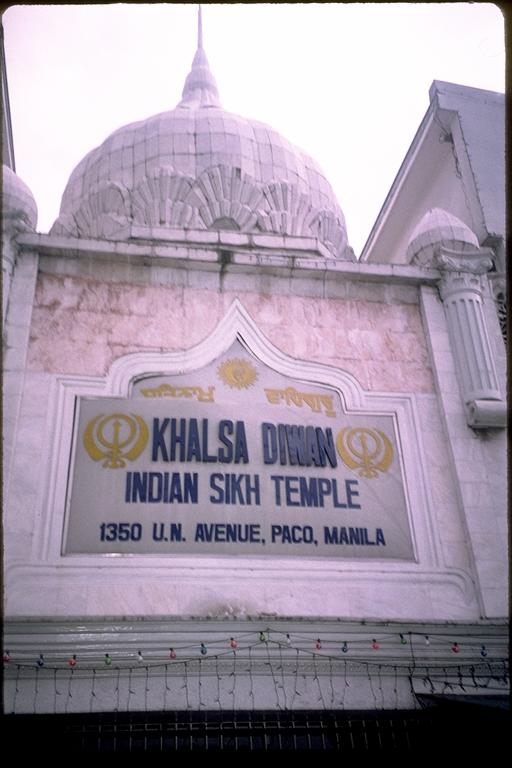
Is this:
(a) The set of Al Capone?
(b) A government paramilitary force under a dictatorship?
(c) The Punjab Police?
(d) Or is it just the story of a gurdwara?
You guessed it: the answer is (d)!
This is the set for the latest episode of “Who Wants to be a Pardhaan (President of the Gurdwara),” and it takes place in Manila, where a battle for control of the local guru ghar has been waged for years. We had heard of this type of thing being publicized in the West (Europe and the Americas), but why should the Phillipines be any different – and undoubtedly this story has just as much drama and un-Sikh-like behavior as any we have heard. It goes something like this:
2004: Bansal became Gurdwara president following a court-supervised elections. After coming into power, he looked into organization’s assets and found that Amardeep’s group (the old committee) had siphoned off P30.6 million from Gurdwara donations to a new corporation they had created—Khalsa Diwan (Sikh Religious Association) Inc.
For many of us Sikhs of Panjabi-background, those Sikhs that chose to embrace Sikhi (often termed as ‘goray Sikhs’, but by no means are all of them of such ‘gora’ background) are sometimes seen as an enigma. Too often stereotypes and easy labels such as ‘hippie’ or ‘weird’, knee-jerk opinions on ‘yoga’, or even a certain ‘guilt’ in terms of our own relationship with our Guru tend to be expressed in hushed tones. 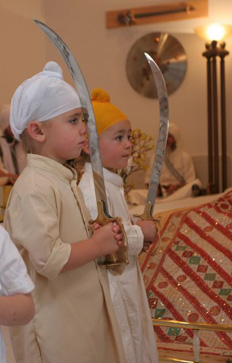 However, such labels only dehumanize those that we should be most embracing as brothers and sisters of a shared Guru.
However, such labels only dehumanize those that we should be most embracing as brothers and sisters of a shared Guru.
A recent article in a local Surrey newspaper recently has me re-thinking how as a Sikh community we can continue to strengthen our Qaum. Reading about Hari Nam Singh Khalsa’s own evolution was not only inspiring, but also a point for reflection.
The Oakville, Ontario resident is the host of the only English-language program on Canadian television that provides knowledge about Sikhi. His “Insight into Sikhism” airs on Saturday mornings throughout Canada (you can click here for Canadian times and channels). On the show’s website, the program’s purpose is described as:
Each week, host HariNam Singh Khalsa explains aspects of the Sikh religion and its relevance to modern day issues. Insight into Sikhism introduces the core principles of Sikhism in a simple and basic format in English for everyone to understand. HariNam Singh’s mission is to spread the universal teachings of Sikhism to people of all faiths.[link]
Although I have never seen the show (if you have, please do comment and let us know your thoughts about it), it seems like a remarkable and much-needed project.
I got this cute video link via ASATA and wanted to share it with TLH. It talks about Italy’s desi-Sikh minority, relations between Italians and Sikhs, and the role of Sikhs in Italy’s cheesemaking industry

